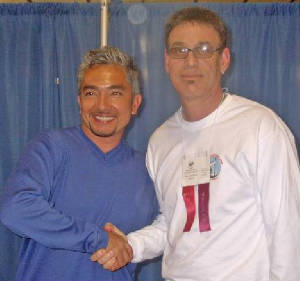Problem Dog Behaviors
 By Dawn Keadic
By Dawn Keadic
Every dog owner must eventually deal with some unwanted behaviors on the part of their four legged companions. Some of the most frequently encountered training problems with puppies and dogs alike are jumping on people and performing those amazing feats of escape.
Jumping up on people
Jumping up on people can be a cute trick for puppies, but it quickly becomes a problem behavior as the dog gets older, larger and heavier. A very heavy dog can easily knock a child or even a small adult of his or her feet, so jumping on people can be a dangerous problem as well as an annoying one.
The reason puppies and older dogs jump on people is obvious – they are excited and happy to see them. Many people are reluctant to discourage this exuberant behavior, but it is important to redirect that happiness and energy in other ways. Many well meaning owners, family members and friends inadvertently encourage this jumping up behavior by picking the puppy up, kissing it or otherwise providing encouragement.
This type of inconsistency is anathema to proper dog training, and in order for the dog to be trained not to jump, every member of the family must recognize and accept the importance of the training. If one member of the family allows the dog to jump up while other family members do not, the dog will understandably become confused and frustrated. The training must be firm, kind and consistent in order to be effective.
One way to redirect the dog’s happiness and excited ness from jumping is to teach him to lift his paw when greeting you. This “shaking hands” posture is an acceptable way for the dog to show his happiness and his respect. Many people even teach their dogs to do simple tricks, like rolling over, instead of jumping on people.
Escaping and roaming the neighborhood
A responsible dog owner would never dream of allowing his or her dog to roam the neighborhood freely. Allowing a dog to roam on its own is irresponsible, dangerous (to the dog and the neighborhood), and probably even illegal. Most towns have ordinances which prohibit dogs from being allowed to roam around free, so you could be in legal trouble if your dog is found wandering the neighborhood unattended.
Of course sometimes that wandering dog is not the owner’s idea, and many dogs perform amazing feats of escape when left on their own. The temptations for unattended dogs are many, including passing bicycles, joggers, children, cats and other dogs. It is much easier to prevent escapes than to recapture a loose dog, so let’s talk about some preventative measures every dog owner can take.
Removing the motivation to escape is a big part of the solution. A bored dog is much more likely to spend his day plotting the great escape. A dog that is surrounded by everything he or she needs, like lots of toys, a soft bed, and plenty of fresh clean, water, is more likely to spend his or her day contentedly sleeping or playing with toys until the owner returns.
In addition, a dog with lots of pent up, unused energy is likely to try to escape. Try incorporating several vigorous play sessions with your dog into your daily routine. Make one of those play sessions right before you leave. If your dog has a chance to work of his or her energy, chances are he or she will sleep or relax much of the day.
Of course dealing with the dog is only half the problem. It is also important to make the property as escape proof as possible, through proper fencing and other measures. For dogs that dig, it may be necessary to extend the fence underground by placing metal stakes in the ground every few feet. For dogs that jump, it may be necessary to make the fence higher. And if none of these measures work, it may be necessary to confine the dog to the house when you are not at home.
Dog lover Dawn Keadic appreciates the benefits of a well-trained dog. There is no nicer compliment than "Wow, your dog listens well, how did you train him?" Dawn shares some secrets of having a well-behaved dog at Puppy Training.
Our Philosophy & Goals
Our philosophy is simple. Improve the life of both dog and family. All too often, unruly dogs do not fully enjoy life because their families constantly become upset and frustrated with them. This is difficult for both family and dog.
Our mission is simple. Make both dog and family happy.
What does is take to make your dog happy? He will thrive when you give him leadership and attention.

Making the family happy is a bit more complex.
Families typically want their dog to:
- Come when called, every time, on or off leash
- Walk nicely on a loose leash without pulling
- Sit until released
- Down until released
Families also want their dogs:
- Not to jump on people
- Not to charge through doors
- Not to dig in the garden
- Not to bark and chew inappropriately
- Not to climb on furniture you prefer they avoid
- Not to sniff and eat off the table and counters.
- Not to be wild and uncontrollable
- Not to ignore you when you want their attention




